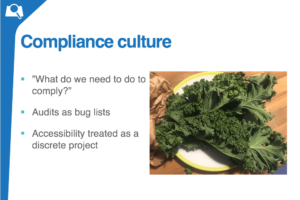Earlier this summer, I was invited to give a talk at an event organized by the Ed-ICT research consortium, in Milton Keynes, UK. Ed-ICT is an international collective of researchers working together to explore the diverse ways in which the experience of learners with disabilities can be improved through technology, with a focus on post-secondary education.

I was asked to share my thoughts as an accessibility consultant, researcher and advocate on the challenges we currently face in improving digital accessibility, and the emerging challenges we need to tackle if we wish to ensure that tomorrow’s digital environment is inclusive to all. My talk slides are available, along with other speakers’ slides, on the symposium programme web page.
I wanted to use this blog post to briefly share some of the challenges I discussed. I didn’t want to base my talk on personal opinion only, so I tapped into the TPGi hive mind to find out what my colleagues thought. These are people who work every day helping organizations to improve the accessibility of their digital resources, and who have extensive experience of the practical difficulties that exist in advancing accessibility. I’m extremely grateful to all my colleagues who responded, and who gave a valuable cross section of perspectives—from consultants, sales and project managers.
The following challenges emerged as common concerns.
Current challenges
Challenges we face right now in promoting and supporting accessibility:
- Education and awareness. We know accessibility knowledge can be hard to acquire and apply. But some concerns relate to a more fundamental lack of basic technical knowledge (HTML basics) or understanding of the needs and circumstances of the people for whom we’re creating digital content.
- Compliance culture. Advancing accessibility is difficult when focus is on doing just enough to comply, when accessibility is seen as a remediation project with a completion date, and audits are treated as bug lists rather than as educational resource.
- Organisational strategy. Related to the previous point, when accessibility is not prioritized as an organization-wide concern, or is considered something to be outsourced, challenges emerge relating to limited expertise, staff turnover, and a lack of continuity and capacity building to sustain and embed accessibility best practice.
Emerging challenges
Challenges that are emerging:
- The effect of “drive-by” lawsuits on laws and standards. As focus concentrates on bare-minimum compliance in response to quelling complaints driven by large-scale automated testing, there is a fear that laws and supporting standards will become unduly influenced by what is considered minimally acceptable to industry over what is needed for people with disabilities. Quality of user experience will be further deprioritized, and a compliance on output (digital resources) will not encourage organisations to invest in strengthening the processes that create these resources.
- Authoring tools and practices. Trends in digital content creation have helped to reduce the need for technical know-how—a good thing! But this leads to an increased reliance on authoring tools, such as those provided by social media platforms to create and share graphics of content (screenshots of tweets, for example), or commercial website builder solutions. Where is accessibility in these content creation tools and workflows? To what extent are accessibility concerns being sacrificed for speed and ease of publication?
- Touchscreens and kiosks. The growing prevalence of these devices can help increase independence, giving us more control over how we access services and purchase goods. But they bring accessibility challenges that, when connected with privacy concerns, may lead to more exclusion for people with disabilities if not dealt with effectively.
Addressing the challenges
For experienced accessibility practitioners, these challenges and concerns may be familiar, confirming current suspicions or experiences. Thankfully, work is underway to address each challenge, including formal funded research projects like We4Authors, partnerships like TeachAccess, standards development work and grassroots efforts. Supporting this work is essential to an inclusive web, and it demands our support and participation as accessibility advocates.
Comments
So true David. We face the same issues is Israel. Though we are advanced in terms of legislation, the commitment of agencies, organizations and companies is not impressive. Most of them are looking for accessibility add-ons (an industry that is booming now in Israel) to install on their website to reduce costs and to satisfy the law only. I am planning to write a post about those add-ons and would love to hear your take on the concept.
We have a problem reaching communities of people with disabilities. For example, a small percentage of people that are blind, actually use a computer and a screen reader. We must find a way to reach them and their families. Investing expensive resources to make websites accessible to people who hardly use them, does not make sense financially.